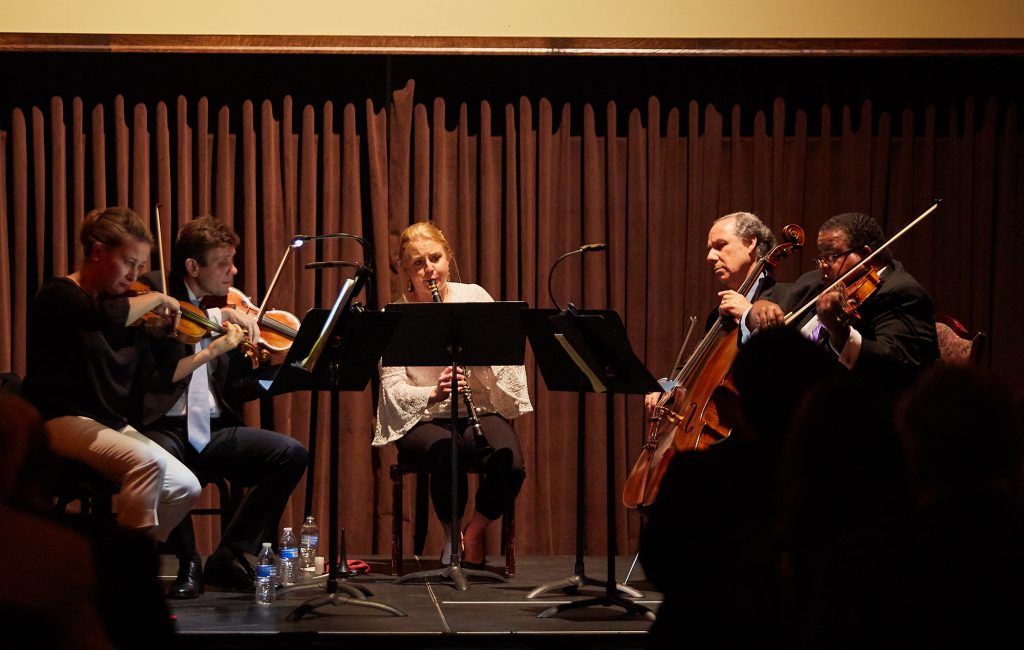
The two canonical clarinet quintets, and there are really only two, attain that status at least in part because listening to them, one wonders why such a beautiful combination isn’t regularly attempted by composers everywhere.
For now, no one’s done it better than Mozart in 1789 and Brahms in 1891, and it was their respective clarinet quintets that occupied a program of the Palm Beach Symphony chamber music series Feb. 27 at the Harriet Himmel Theatre at CityPlace in West Palm Beach.
On hand for the quintets was clarinetist Anna Brumbaugh, joined by violinists Evija Ozolins and Valentin Mansurov, violist Chauncey Patterson and cellist Claudio Jaffé. Introductory notes were given by Lynn University professor and composer Thomas McKinley, who reminded the small audience that both composers had written these works late in their careers after meeting an exceptional clarinetist: Anton Stadler, for Mozart, and for Brahms, Richard Mühlfeld.
The Mozart in that sense is the more remarkable in that the clarinet was very much in transition in the late 18th century, and composers were only just beginning to include the instrument in their orchestral scores. His quintet (in A, K. 581), like the Clarinet Concerto he also wrote for Stadler, is one of the first great showcases of the range and expressivity of this instrument.
Brumbaugh is an excellent clarinetist with a sweet, well-rounded sound and ample technical accomplishment. She also plays very much as a member of an ensemble and not as a soloist with a quartet of accompanists; that gave the performance a sense of friendly intimacy but also made it somewhat unassertive at times.
In the Mozart quintet, there were fine moments such as early in the first movement after the introductory material, when the violin introduces the secondary theme, the cello plays pizzicato, and then the clarinet steals in with a minor-key treatment of the same tune over a sudden pianissimo: Wholly Mozart, and nicely managed by the players, who were careful throughout the concert to observe a wide range of dynamics.
Aside from the slightly reticent feel at times, the only other blemish on this otherwise lovely and satisfying performance was in the first movement, as Ozolins’ intonation was noticeably flat (she retuned later in the performance).
The Brahms quintet (in B minor, Op. 115), for which McKinley in his remarks singled out how Brahms had used the Mozart quintet as a model when he came to write his own a century later, sounded even more intimate and personal than the Mozart. It’s also more difficult in some ways, but these veteran players rose to the occasion.
There were many subtle touches to admire here, not the least of which was the skill with which the often very complicated sonic texture was managed. In lesser performances, this music can sound awkward or strangely violent, but here the music was simply elaborate and broadly expressive. And Brumbaugh’s highlights included her deft handling of the florid cadenza-style flourishes in the second movement, and her playful shout-outs of the fast downward diminished chords in the third, cheekily echoed by her string-playing companions.
This was a fine night of chamber music, especially because the two works on the program are undoubted masterpieces that remain remarkable examples of how to integrate the clarinet into a string quartet and create a far bigger sound world thereby. The chamber musicians of the Palm Beach Symphony did no more or less than give these pieces the respect and devotion they deserve, and that, happily, was more than enough.